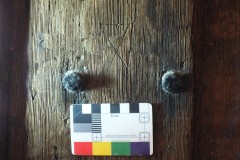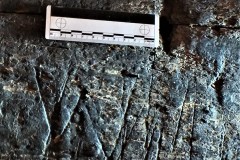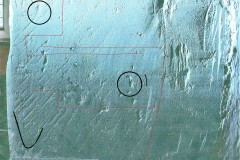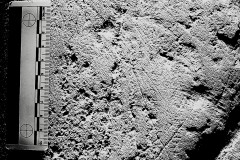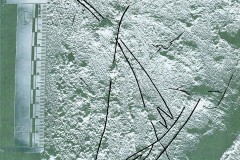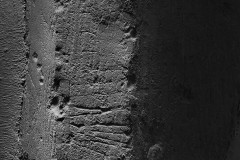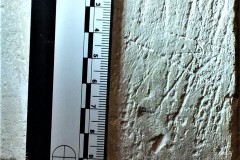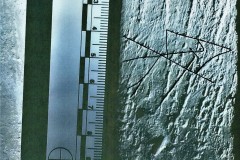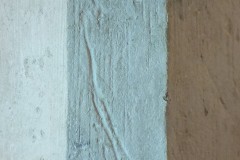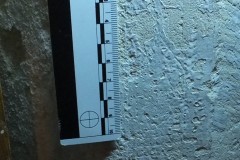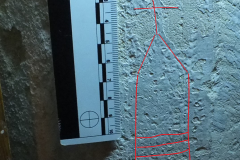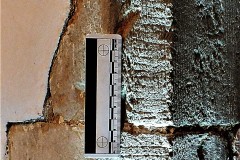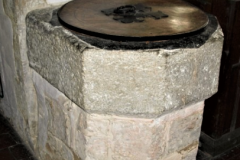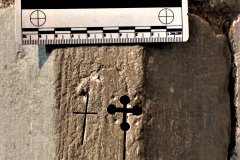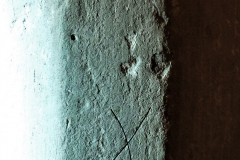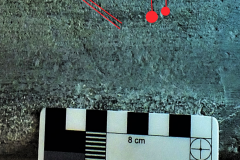The Graffiti of St Giles, Wormshill and All Saints, Iwade
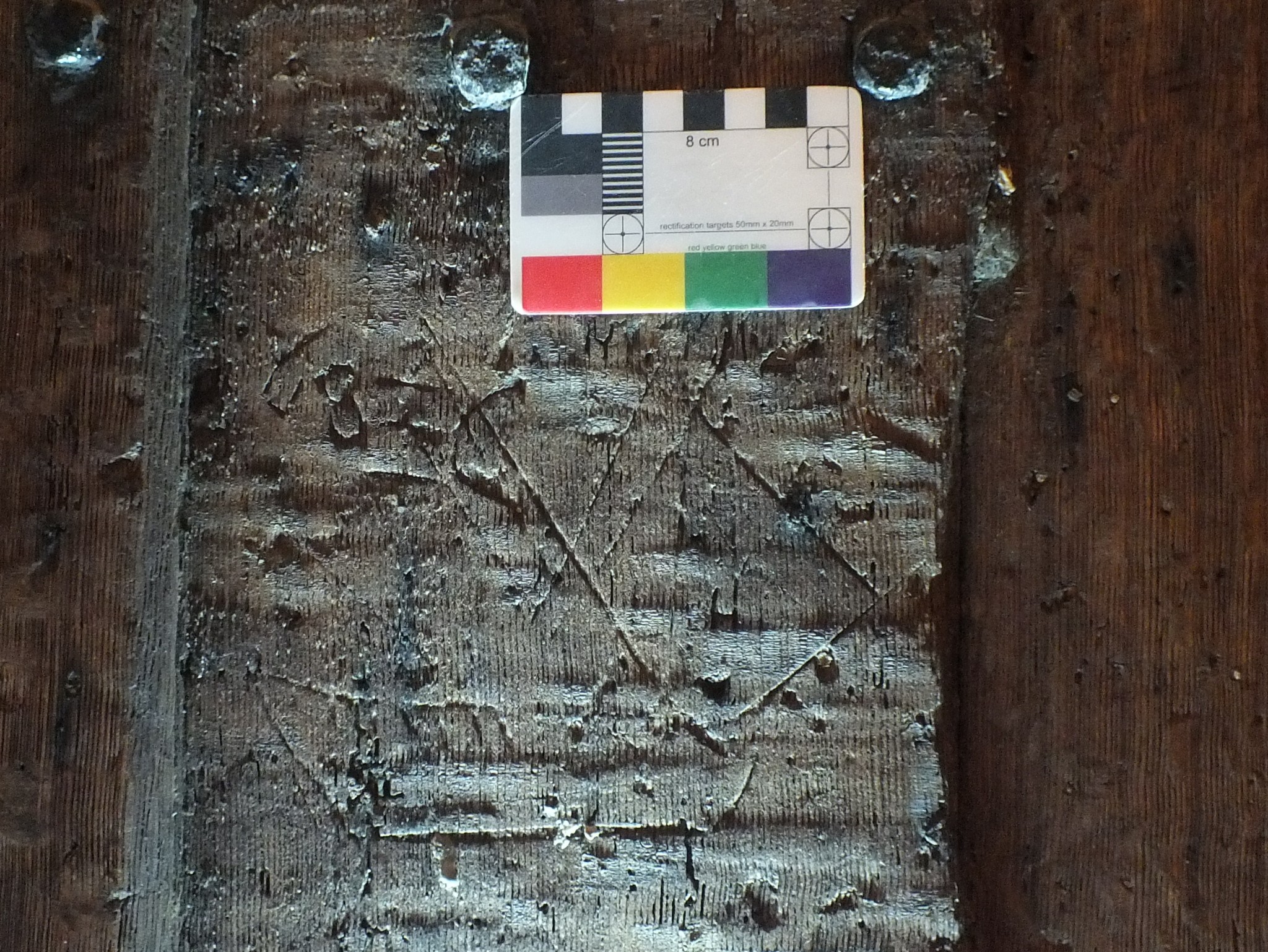
Alan Anstee of the Kent Medieval Graffiti Survey talks about two churches near Sittingbourne in Kent.
When looking through the surveys of these two churches prior to starting to write this, I was struck by the difference in what was found in each church. This led to the question asked in the final paragraph.
There are two small churches, All Saints, Iwade and St Giles, Wormshill, about 8 miles apart, near Sittingbourne, Kent. All Saints lies north-west of Sittingbourne, with St Giles being south of the town. St Giles is thought to have been first built in the late Saxon period, shortly before the Conquest. All Saints, whilst medieval is about 200 years later than St Giles. When surveyed, in November 2014 and August 2015 respectively, both were whitewashed internally, with that of St Giles flaking badly in places. Neither church has enough graffiti to write a standalone piece but as each has something of interest I decided to write about both.
St Giles has the most graffiti, mainly crosses; but also has a very interesting late 12th century decorated parish chest. The decoration of this chest is, at least, the equal of any similar chest I have seen although the date of the decoration is unknown.
Although, at All Saints there is very little graffiti, it does have a boat, possibly from the 17th century, on the south door, and a nice collection of mason’s marks. No attempt was made to photograph all of these marks, but at least one example of every design of mark was recorded and is shown here.
The graffiti will be described by type for both churches, starting with Apotropaic graffiti.
A) Apotropaic
All Saints, Iwade:-
1) What seems to be an unfinished “butterfly” mark, on the south face of the south
door.
St Giles, Wormshill :-
2) A possible “VV” on the lid of the parish chest. This may be a letter “W” but as there is no other letter with it, it seems more likely that it is a Marian “VV” mark.
3) The very faint remains of two circles and some rectilinear patterns on the 3rd pillar from the east wall.
4) The above enhanced.
5) Various odd lines that look deliberate on the southwest face of the east pillar. These may have once formed an apotropaic mark. However, this is by no means certain and may be a case of an over-active imagination.
6) The above enhanced.
7) A “tally” or “ladder” mark on the southwest face of the east pillar.
8) Some faint lines which seem to make a geometric shape on the west face of the 3rd pillar from the west wall.
9) The above enhanced.
10) Two rough intersecting lines, with a third across the bottom, on the southwest face of the 3rd pillar from the west wall.
11) What seems to be a cross on top of a tall “house”-shaped “ladder” mark under the paint, on the southeast face of the 3rd pillar from the west wall.
12) The above enhanced.
13) A “tally” mark on the southeast side of the 3rd pillar from the east.
B) Crosses
All Saints, Iwade :-
14) A rough asymmetrical cross on the northwest side of the 2nd pillar from the east.
15) What looks like a chisel cut cross is on the north side of the base of the font, . At
first this was thought to be the work of a mason but it is not in the centre of the
base. Also although it is quite sharp it just does not feel right for mason’s work.
St Giles, Wormshill :-
16) A small cross about 3.5 cm by 3 cm, on the northwest face of the 3rd pillar from
the west wall.
17) A St Andrew’s cross on the lip of the lead liner of the font, which is believed to
be Saxon. (See photo 17a.)
18) A cross about 8 cm high on the southeast face of the 3rd pillar from the west wall.
19) Four small rough crosses on the southeast face of the 3rd pillar from the east wall.
20) A quite intricate but rather rough cross on the southeast face of the 3rd pillar from
the east wall.
21) Three rather faint crosses, one of which was originally quite nice, on the southeast
face of the 3rd pillar from the east wall.
22) The above enhanced.
23) A faint and fairly rough St Andrew’s cross on the southeast face of the 2nd from
the east wall.
24) The above enhanced.
C) Initials
All Saints, Iwade :-
25) South door, south face, the initials “BA”.
26) As above, the number “68” and initials “JC”, which may be associated with the
boat in section F.
D) Mason’s marks
All Saints, Iwade :-
27) A mason’s banker on the northeast face of the 1st pillar east of south door.
28) Various mason’s marks, on the arch between the first two pillars east of the south
door.
29) Close up of the lower two mason’s marks on the above. The upper one probably a
banker.
30) Close up of the centre mason’s mark, possibly a banker, on the above.
31) Close up of the upper mason’s mark, a banker, on the above.
32) South door arch, west side. Probably two bankers.
33) East pillar west face. A mason’s banker.
34) The above enhanced.
35) Two mason’s alignment marks on the 2nd pillar from the east wall.
E) Other Graffiti
All Saints, Iwade:-
36) South door south face. A boat with similarities to a 17th century fishing vessel.
St Giles, Wormshill :-
37) Due to the flaking paint it is difficult to be certain but it seems to be a head wearing a crown. If so, this is probably Christ or perhaps a King. Southeast face of the 1st pillar east of the south door.
D) Parish Chest
St Giles, Wormshill :-
38) The front of the chest.
39) The above enhanced, to better show the decoration.
Hopefully this has shown that the graffiti in two medieval churches both within a five-mile radius of the same town can vary greatly. Although, there was little graffiti in either church that which was found was predominantly in St Giles.
This is something I noticed soon after I started researching and surveying graffiti. The question arises as to why some churches are covered in mason marks and others have none. These two churches are typical of this. This year the Kent Medieval Graffiti Survey has twice met stone masons who said that they never put their marks where they show and were surprised when shown the marks in those churches. Which returns to the question why are masons’ marks, not just bankers but location and alignment marks, visible in some churches and not in others?
Correspondent: Alan Anstee
St Giles Church
The Street
Wormshill
Kent
ME9 OTT
All Saints Church
14 The Street
Iwade
Sittingbourne
ME9 8SJ
Search terms: Kent Medieval Graffiti Survey, apotropaic, mason’s marks, banker marks, alignment marks, crosses, Calvary cross, graffiti, ship, boat, initials, VV, Marian mark, St Andrew’s cross

